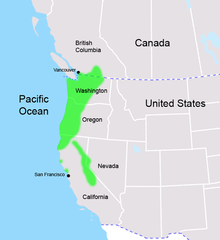| Hystrichopsylla schefferi | |
|---|---|
|
Scientific classification
| |
| Domain: | Eukaryota |
| Kingdom: | Animalia |
| Phylum: | Arthropoda |
| Class: | Insecta |
| Order: | Siphonaptera |
| Family: | Hystrichopsyllidae |
| Genus: | Hystrichopsylla |
| Species: | H. schefferi
|
| Binomial name | |
| Hystrichopsylla schefferi Chapin 1919
[1]
| |

| |
| Distribution of host species | |
| Synonyms | |
|
Hystrichopsylla hubbardi Augustson 1953 | |
Hystrichopsylla schefferi, also known as the mountain beaver flea and giant mountain beaver flea, is a parasitic nearctic insect and a flea, belonging to the order Siphonaptera, the fleas. With an adult body length of as much as 0.5 inches (13 mm), it is the largest living flea in the world, and is native to the American Northwest. [2] Though most members of the genus Hystrichopsylla are not strongly associated with any particular host animal and will parasitize insectivores and rodents generally, [3] H. schefferi is monoxenously associated with the mountain beaver with which its range is coterminous. [4] The fleas of the family Hystrichopsyllidae, along with the family Pulicidae, are the oldest of fleas in evolutionary history. [5] H. schefferi can be distinguished from the very similar and closely related species Hystrichopsylla gigas dippiei by the number of spines in the pronotal comb, as H. g. dippiei has 36 and H. schefferi has 46. [6]
See also
References
- ^ Chapin, Edward A. (April 1919). "New species of North American siphonaptera". Bulletin of the Brooklyn Entomological Society. 14 (2). Brooklyn Entomological Society: 49–61.
- ^ Yoon, Carol Kaesuk (29 July 2014). "The Great Giant Flea Hunt". New York Times. New York. pp. D1. Retrieved 29 July 2014.
- ^ Gunvor Brinck-Lindroth; F.G.A.M. Smith (22 June 2007). The Fleas (Siphonaptera) of Fennoscandia and Denmark. Brill. p. 32. ISBN 978-90-04-15151-2.
- ^ B.F. Eldridge; J.D. Edman; John Edman (31 December 2003). Medical Entomology: A Textbook on Public Health and Veterinary Problems Caused by Arthropods. Springer Science & Business Media. p. 111. ISBN 978-1-4020-1794-0.
- ^ Boris R. Krasnov (8 May 2008). Functional and Evolutionary Ecology of Fleas: A Model for Ecological Parasitology. Cambridge University. p. 33. ISBN 978-1-139-47266-1.
- ^ Henry Ellsworth Ewing; Irving Fox (1943). The Fleas of North America: Classification, Identification, and Geographic Distribution of These Injurious and Disease-spreading Insects. U.S. Department of Agriculture. p. 89.